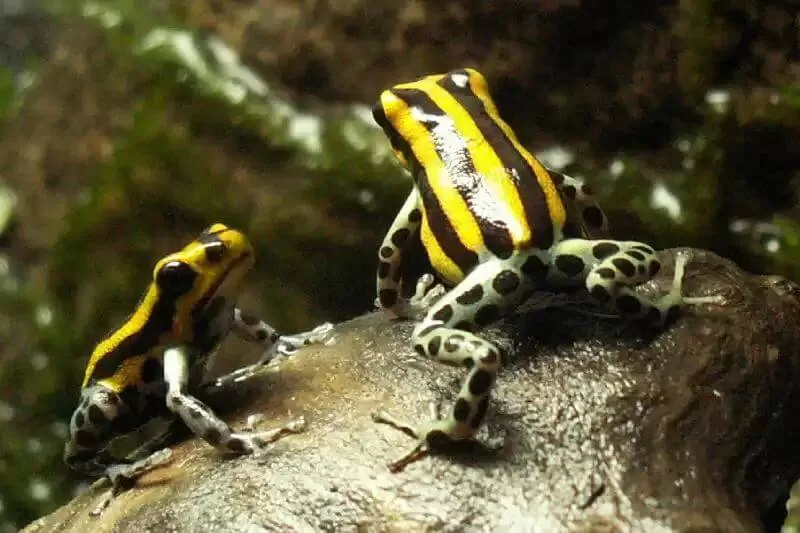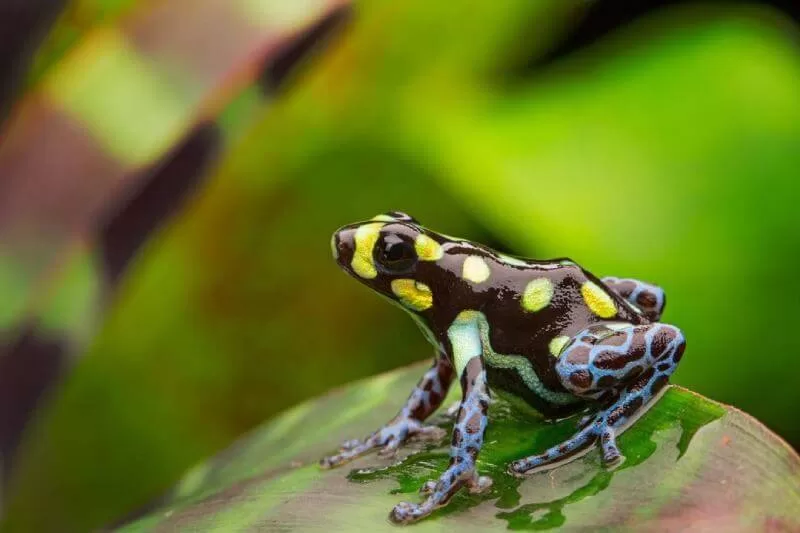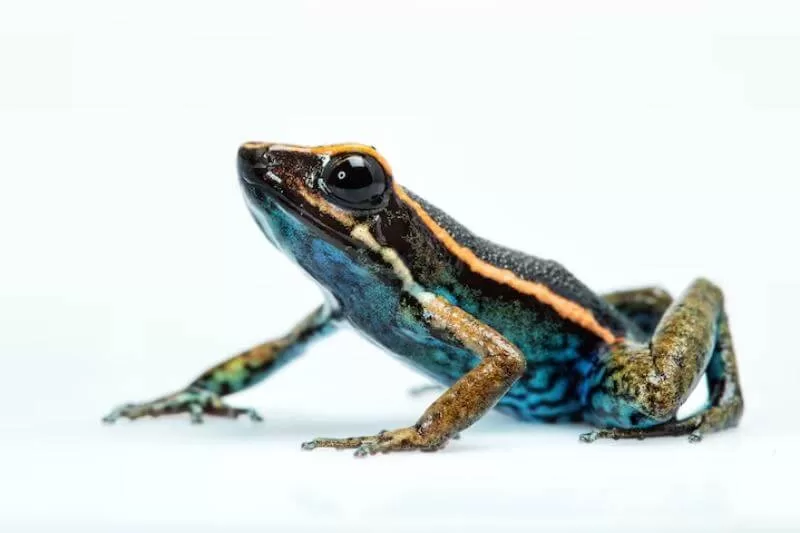Manu National Park is home to some colorful and poisonous amphibians. Among them, the recently discovered Ameerega shihuemoy, which put frogs in the spotlight. Manu’s poisonous frogs are fascinating.
The Ameerega shihuemoy thrives in Manu’s unique environment, showcasing the variety of different creatures still to be discovered. But before Amaeerega, there were others. And all these frogs have a role in the balance of the rainforest..
In this blog post, we dive into the mysterious world of Manu’s poisonous frogs. We’ll explore the significance of the Ameerega shihuemoy discovery. Join us as we unveil the secrets of these small frogs. Maybe you will encounter them in your next visit with us.
In the Amazon Basin lies a marvel of nature, the Manu National Park. This protected area, home to Manu’s poisonous frogs. The humidity makes the perfect home for a lot of amphibians. Among its most vibrant inhabitants are the poison dart frogs.
These small creatures pack a punch with their vivid colors and potent venom. They thrive in the lush environments of Manu. From lowland rainforests to cloud forests. Their presence in Manu highlights the park’s rich biodiversity.

Manu’s poisonous frogs are not a danger, if left alone. Their colors are a warning. Bright hues tell predators of the toxicity in the frog’s skin. Each color, from electric blue to sunny yellow, adds to the forest’s vibrancy.
These frogs prefer the humid, shadowy floors of the forest. Here, they find the insects that form their diet. The frogs’ poison comes from these very insects.
Manu’s poisonous frogs play a critical role in the ecosystem. They help control insect populations, maintaining ecological balance. Their existence is vital to the health of the forest.
The frogs also serve as indicators of environmental health. Their sensitivity to pollution and habitat change alerts scientists to ecosystem shifts. Thus, they help monitor the well-being of Manu National Park.
This protected area, spanning from Andean highlands to the Amazon lowlands, is a refuge for these frogs. The reserve zone, cultural zone, and buffer zone offer varied habitats. These zones support diverse species of poison dart frogs.
The Manu River, winding through the park, and the Madre de Dios River, define this pristine forest. Oxbow lakes scattered throughout the area provide additional habitats for wildlife. Here, Manu’s poisonous frogs find their perfect home.
Manu National Park is not just a national park; it’s a UNESCO Biosphere Reserve. This designation underscores its global importance for conservation. The park protects not only frogs but also hundreds of tree species and species of birds.
In Manu, indigenous peoples live in harmony with nature. They share the land with Manu’s poisonous frogs and other wildlife. This coexistence has lasted for centuries, rooted in respect and understanding.
The Amarakaeri Communal Reserve, adjacent to Manu, exemplifies this relationship. Here, communities work to preserve their homeland and its biodiversity. They are the stewards of the forest, ensuring its protection for generations to come.
In the vast expanse of the Amazon Basin, within the bounds of Manu National Park, lies a small but mighty guardian. Manu’s poisonous frogs, with their vivid colors and potent venom, play a pivotal role in the ecosystem. They are more than just a beautiful spectacle; they are crucial to the health and balance of their environment.
These frogs contribute to biodiversity, acting as both predator and prey. Their diet mainly consists of insects, helping control the population of these even smaller creatures. This balance is essential for the health of the ecosystem.
Moreover, the very existence of Manu’s poisonous frogs indicates a healthy environment. Their sensitivity to changes in their surroundings makes them vital indicators of ecological health.
The Amazon rainforest, a vast network of life, relies on every creature to maintain its balance. Here, Manu’s poisonous frogs serve a crucial role. They keep insect populations in check, ensuring that no single species dominates the forest floor.
Their role extends beyond just being predators. The frogs themselves are prey for larger animals. This dynamic is a crucial part of the food web in Manu National Park.
In managing insect populations, these frogs also protect plant life. Many insects are harmful to plants. By controlling these insects, the frogs indirectly support the health of the forest’s flora.

Manu’s poisonous frogs also contribute to the nutrient cycle. Their droppings fertilize the soil, enriching it with essential nutrients. This process supports plant growth, contributing to the lush vegetation of the Amazon rainforest.
Their presence in diverse habitats, from cloud forests to lowland rainforests, showcases their adaptability. Each species of poison dart frog has found its niche within these environments. This diversity ensures the resilience of the ecosystem.
Manu National Park, as a protected area and biosphere reserve, offers a sanctuary for these frogs. It ensures their survival, allowing them to continue their role as guardians of the forest.
Manu’s ecosystem is a complex web of interactions. Here, Manu’s poisonous frogs play a part in a larger symphony.
The frogs’ calls are part of the natural sounds of the forest. They are louder when it rains. This is a mating call. The sounds of the forest shows the circle of life unfolding around visitors.
Manu National Park, stretching from the high Andes to the lowland rainforest, provides a home for these frogs. It spans a range of elevations, climates, and ecosystems. This variety supports a wide range of species, both flora and fauna.
Manu National Park cradles a secret. Here, amid the lush greenery and diverse wildlife, lies a recent discovery. The Ameerega shihuemoy, one of Manu’s poisonous frogs, has captured the attention of scientists and nature enthusiasts alike.
This tiny amphibian, with its vibrant hues and elusive nature, adds to the rich tapestry of life in Manu. Its discovery underscores the vast, unexplored wealth of the Amazon rainforest. The Ameerega shihuemoy symbolizes the ongoing quest to understand our planet’s biodiversity.
The discovery of the Ameerega shihuemoy was a milestone. It highlighted the importance of continued exploration in areas like Manu. This finding was not just about a new species; it was a reminder of the diversity of the reserve.
Manu National Park, a protected area and biosphere reserve, provides the perfect habitat for this frog. The park’s diverse ecosystems support a myriad of life forms. The Ameerega shihuemoy is just one of the many species that call it home.
The Ameerega shihuemoy thrives in the humid, dense forests of Manu. Its presence adds to the ecological complexity of the area. The frog’s diet, breeding habits, and habitat preferences are subjects of ongoing research.
Manu’s pristine forests and oxbow lakes offer an ideal setting for the Ameerega shihuemoy. These ecosystems provide shelter and food, critical for its survival. The frog, in turn, contributes to the delicate balance of these habitats.
Manu’s poisonous frogs, including the Ameerega shihuemoy, play vital roles in their ecosystems. They help control insect populations, acting as natural pest control. This balance is essential for the health of Manu’s forests.
The frogs’ presence also benefits the flora of Manu. By keeping insect populations in check, they protect plant life. This interaction underscores the interconnectedness of Manu’s ecosystems.
The discovery of the Ameerega shihuemoy highlights the importance of conservation efforts in Manu. Protecting areas like Manu National Park ensures that species like the Ameerega shihuemoy can thrive. These efforts safeguard the park’s unique biodiversity for future generations.
Conservation also involves the local indigenous peoples. Their knowledge and respect for the land play a crucial role in preserving Manu’s natural heritage. Together, these efforts form a comprehensive approach to conservation in the Amazon Basin.

If you got any questions, please do not hesitate to send us a message. We reply within 24 hours!
+51 900 394 399
info@biomanuexpeditions.com
reservas@biomanuexpeditions.com
